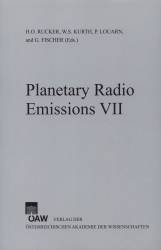
Planetary Radio Emissions VII, pp. 475-486, 2011/12/28
Proceedings of the 7th International Workshop on Planetary, Solar and Heliospheric Radio Emissions held at Graz, Austria, September 15–17, 2010

Currents on the conducting surfaces of the spacecraft hull, induced by electric fields of radio waves, strongly influence the reception properties of spacecraft antenna systems. This influence is visualized by the so-called ”effective antenna length” (heff ), representing the electric antenna, which differs from the physical antenna rod. Knowledge on these effective antenna vectors can be yielded by several different methods: (1) Experimental rheometry, (2) Numerical computer simulations, (3) In-flight calibration, and (4) Experimental anechoic chamber measurements. The paper addresses these methods and shows in the case of preliminary design studies of Solar Orbiter spacecraft the possibilities of numerical computer simulations, in particular the change of heff by design variations. The combined use of the above mentioned methods enables the determination of heff over a wide frequency range, the correct information on wave polarisation, and in specific cases helps to improve the performance of direction finding. So the calibration results may also be used to re-evaluate structure and position of antennas (and even positions of instruments) on board a spacecraft.